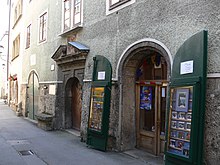Sebastian step
Sebastian Stief (born January 11, 1811 in Tengling near Tittmoning , then part of Salzburg , from January 1, 1816, part of Bavaria; † July 29, 1889 in Salzburg) was a Salzburg painter in the late Biedermeier period .
Life
Sebastian Stief was born as the son of the married couple Josef and Elisabeth Stief, who worked as tailors, and caught the eye early on for the lifelike portraits of teachers and classmates that he drew with charcoal or chalk on walls or barn doors.

He received his first drawing lessons from the painter Johannes Neumüller in Traunstein; an eye disease forced the young Sebastian to take a break from art. It was only after this ailment had been resolved that he could begin studying at the Munich Art Academy with the help of a royal scholarship. Here he became a student of the then famous painters Peter von Cornelius and Julius Schnorr von Carolsfeld , who guided him in the direction of the Nine-Azarean style . His pronounced talent for portrait painting earned him a commission from the Bavarian King Ludwig I to paint a son and two daughters of the king, which was a brilliant recommendation for Stief for his artistic future. After completing his four-year studies, he earned his living from 1832 with miniature and portrait painting in Munich, Regensburg and Passau.
He gave up a tin toy factory in Seekirchen, which he had inherited, in 1838 because of the great competition from Nuremberg. In 1839, Stief moved into a house at Pfeifergasse 4 in Salzburg, where he lived with his family. Sebastian Stief died on July 29, 1889 in Salzburg and is buried in the family crypt in St. Peter ; a downtown alley in Salzburg near his home is named after him.
"He deserves to be called the most important portrait painter in Salzburg of the 19th century." (Lieselotte Hoffmann)
Works
He created a total of 821 paintings, including 555 portraits, some of well-known personalities (such as two archbishops, the founder of the Salzburg Museum, Vinzenz Maria Süß, and Franz Xaver Gruber , the composer of the " Silent Night "). These pictures are "solid works of photographic accuracy, neat application of paint and amiability characterize these pictures" in the late Biedermeier Nazarene style (Hans Roth). One of Sebastian Stief's best-known pictures from 1885 is called: Arrival of St. Rupertus with his companions Chuniald and Gislar in sight of the Roman ruins of Iuvavum (Salzburg); The picture of the construction of the first Salzburg Cathedral by Saint Virgil is also praised.
His self-portrait from 1855 hangs in the Salzburg Museum in the Neue Residenz. When numerous churches were redesigned after 1850, he found a rich field of activity here, as evidenced by the many sacred images in churches in the Rupertiwinkel. In his birthplace Tengling, the altarpieces in the Tenglinger and Burger Church (side altars) and the image of Our Lady in the Gessenhausen Chapel are from his hand. In the city of Salzburg he created at least 60 altarpieces (St. Sebastian, the apse in the parish church Maria-Hilf-Leopoldskron-Moos), others in the state of Salzburg (Ebenau, Hallwang, Piesendorf, St. Aegidi near St. Michael im Lungau) as well Side altars in Seekirchen and Thomatal.
Portrait of Franz Xaver Gruber (1846)
Arrival of St. Rupertus (1885)
Portrait of Vinzenz Maria Suess
Portrait of the Salzburg mayor Sigmund Haffner
- 1851 altarpieces in the parish church of Pischelsdorf am Engelbach
- 1853 Stations of the Cross in the parish church of Berndorf near Salzburg
literature
- Constantin von Wurzbach : Stief, Sebastian . In: Biographisches Lexikon des Kaiserthums Oesterreich . 38th part. Imperial and Royal Court and State Printing Office, Vienna 1879, pp. 346–349 ( digitized version ).
- Lieselotte Hoffmann: Sebastian Stief. A Salzburg Biedermeier painter . New publishing company Mirabell, Salzburg 1950
- N. Schaffer: Step Sebastian. In: Austrian Biographical Lexicon 1815–1950 (ÖBL). Volume 13, Verlag der Österreichischen Akademie der Wissenschaften, Vienna 2007–2010, ISBN 978-3-7001-6963-5 , p. 250 f. (Direct links on p. 250 , p. 251 ).
Web links
Individual evidence
- ^ Lieselotte Hoffmann: Sebastian Stief. A Salzburg Biedermeier painter , Salzburg 1950, p. 17
| personal data | |
|---|---|
| SURNAME | Step, Sebastian |
| BRIEF DESCRIPTION | Salzburg painter |
| DATE OF BIRTH | January 11, 1811 |
| PLACE OF BIRTH | Tengling |
| DATE OF DEATH | July 29, 1889 |
| Place of death | Salzburg |



